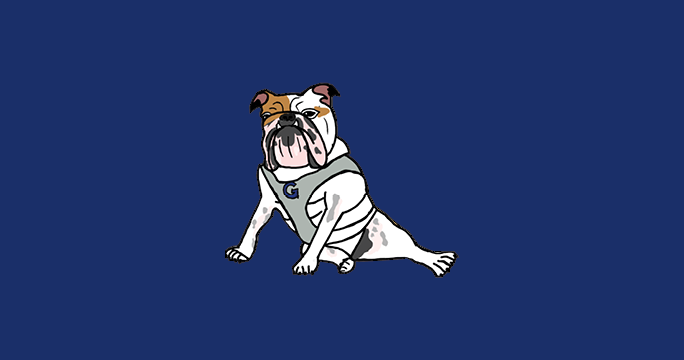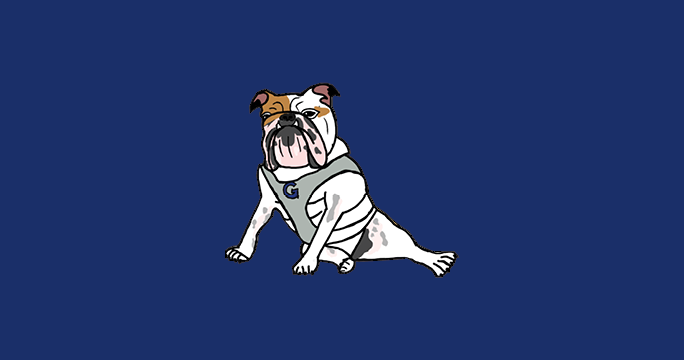Separated by the distance of summer, Georgetown University students were suddenly united in grief over the loss of Jack the Bulldog, who passed away unexpectedly nearly three months ago. His death received national attention, with Fox News and The New York Post articles circulating the internet.
New details obtained by The Hoya reveal that Jack the Bulldog, Georgetown’s beloved mascot, died from complications with an intestinal disorder known as canine intestinal lymphangiectasia.
Students and community members alike were upset at the news, many having viewed Jack as integral to the Georgetown spirit. Among them is Harrison McCarthy (CAS ’26), the in-game officer for Hoya Blue, who helps to lead chants and encourage school spirit on campus.
“This summer when I saw Jack the Bulldog died I was really surprised because it felt very out of the blue,” McCarthy said in an interview with The Hoya. “The Hoya Blue group chat immediately blew up with everyone trying to figure out if we knew anything, which we didn’t.”
“I felt like we lost a big symbol of the Georgetown community,” McCarthy added. “Jack the Bulldog was more than just our mascot or a shared pet.”
The late mascot, who was the eighth bulldog to don the blue and gray pride of Georgetown, was just four years old when he passed away, leading to questions surrounding his health, care and the ethical practices around housing a live mascot.
Rest in Peace, Jack
Born on January 24, 2019, Jack officially arrived on campus six months later and enjoyed eating berries and spending time with students. He was taken care of by a university-employed caretaker and a handful of meticulously selected students, known as Jack Crew.
Jack Crew is composed of roughly ten students each year who take Jack for walks, feed him treats and supervise him at events like sports games.
Kirk Zieser (SFS ’22) began working with Jack the Bulldog and Jack Crew his sophomore year. He fondly remembers attempts to teach Jack to skateboard, playtime with Jack in Capital One Arena and the admiration many students had for their mascot.
“Jack was always being stopped by students and it was fun to see students who were seeing him, whether it was for the first time or the 50th time,” Zieser said in an interview with the Hoya. “That was always pretty special.”
Jack’s wellbeing is the top priority for Jack Crew, Zieser said, whether that be on an everyday walk or during halftime at the men’s basketball games.
“Jack Crew does a very good job of putting Jack’s needs first. He’s really well loved, he’s cared for,” Zieser said. “I think that the life of Jack as a college mascot is a really unique one, especially as far as compared to what a typical dog who lives at home might experience.”
Jack’s intestinal disease is characterized by the dilation of lymphatic vessels, which leads to the leakage of lymphatic fluid into the intestine, according to Dr. Wendy Deal, a staff veterinarian for VCA Animal Hospitals.
“The fluid is rich in protein, which causes protein levels in the blood to decrease (most importantly, albumin), sometimes to dangerously low levels,” Deal wrote in an email to The Hoya.

Symptoms of the disease can include weight loss, vomiting, diarrhea, change in appetite and fluid accumulation in the tissue of lower limbs or in body cavities. The disease is usually treated through drugs, steroids, vitamin supplementation or dietary therapy, Deal said.
The average lifespan of English Bulldogs is between eight and ten years, and while dogs of any age can be affected by canine intestinal lymphangiectasia, Deal said it is most common in middle-aged dogs. The disease can vary in severity, and some dogs respond well to diet modifications and medications while others do not, Deal said.
“For dogs that do respond to therapy, the disease can go into remission for months to years,” Deal wrote. “Many dogs are eventually euthanized due to severe malnourishment, chronic diarrhea, or persistent body cavity effusion, especially pleural effusion, which can cause respiratory distress.”
Despite repeated attempts made by The Hoya, university administrators declined to comment on the process of Jack’s treatment or on the severity of his disease.
The Hoya also reached out to a handful of current Jack Crew members, who declined to comment on Jack’s health.
The wellness of Jack the Bulldog was overseen by Cory Peterson, the director of the Office of Neighborhood Life. Peterson declined to interview with The Hoya.
Ellie Cush (NHS ’20), a former member of Jack Crew, helped to train Jack, whom she lovingly referred to as Puppy Jack, or P.J. for short.
“Jack came to campus when he was just six months old, so we got to introduce him to his new home and watch him grow lovingly into the role of mascot,” Cush wrote in an email to The Hoya.
“Much of the training was also learning about the individual Jack, like with any new dog — things he loved, what caught his curiosity, and paying attention to his cues of how he’s feeling in any given situation,” Cush added.
The university has trained a handful of English bulldogs, not all of which have gone on to assume mascot duties.
In 2013, Jack Jr. (J.J.), a 2-year-old bulldog who was training alongside Jack Sr., the second Jack the Bulldog, was released from mascot duties and training after he was determined unfit for the mascot role.
“After 15 months of monitoring and training, in consultation with these experts and the breeder, we determined that returning to a home environment is what is best for J.J.,” Georgetown released in a statement at the time.
However, according to a 2015 article from The Hoya, Jack Jr. was retired after an incident in which he bit a child.
Jack’s caretaker in 2013, Reverend Christopher Steck, opposed the university’s decision to release J.J. from mascot duties, according to ESPN.
“The university’s decision is a surprise and disappointment to me,” Steck wrote in an open letter, according to ESPN. “I genuinely believe that J.J. would thrive as the next university mascot.”
Steck declined to interview with The Hoya about Jack the Bulldog.
The Ethical Debate of Live Mascots
Just three days after Jack’s death, People for the Ethical Treatment of Animals (PETA), published an article criticizing Georgetown for their use of live mascots, more specifically English Bulldogs, which they consider BIBs, or a breathing-impaired breed.
“As a prestigious university, Georgetown shouldn’t taint its reputation by promoting support for cruel breeders and driving demand for BIBs,” PETA wrote. “It’s time for it to end its cruel, archaic tradition of exploiting bulldogs as live mascots and switch to using a costumed human.”
Dr. Patricia Foley, the former director of the Division of Comparative Medicine and attending veterinarian at Georgetown, said that so long as Jack is treated in a loving and safe manner, she sees nothing wrong with having a pet dog as a mascot.
“I think the Georgetown Jacks have always been loved by students and faculty, and so long as the dogs are enjoying it too, it seems like a win-win to me,” Foley said in an interview with The Hoya.
Animal rights activists have pushed for an end to universities endorsing live mascots. A 2011 research article from Marquette University on the mistreatment of animal mascots specifically calls for the NCAA to make regulations against the use of live mascots.
“A tiger does not belong in a stadium in front of tens of thousands of fans at a football game, in a cage, with cheerleaders jumping on top of the cage,” the article says. “The Colorado buffalo should also not be led out onto a field in front of screaming fans because it could create a dangerous situation.”
However, a pet bulldog is a much more domestically acclimated animal than something like a caged zoo animal, Foley said.
“We’re talking about a pet dog essentially. To me, that’s a very different situation than LSU that has a tiger, something like that,” Foley said.
“Bulldogs are generally very friendly animals,” Foley added. “They love being around people.”
Lori Shindle, a referral manager at VCA Animal Hospitals, concurred.
“I see no issue with live mascots as long as the animal is domesticated and cared for by individuals that are familiar with its specific needs, including veterinary care,” Shindle wrote in an email to The Hoya.
Georgetown is not the only university to have a live bulldog as the mascot. The University of Georgia, Yale University and fellow Big East member Butler University, among others, also house a bulldog.
The benefit of having a bulldog on campus, Foley said, is in the significance of the human-animal bond.
“The power that animals have to make a difference in people’s lives, it’s just so powerful,” Foley said.
Zieser said having a pet on campus can also help homesick students.
“A lot of students miss their own pets at home when they come to Georgetown, so just seeing a dog can be really comforting in a lot of ways,” Zieser said.
So long as overwhelming activities such as high environmental temperatures, travel and exposure to loud noises are kept numbered, Shindle said she believes the benefits of universities housing live mascots can be favorable.
“There are certainly positive psychological effects to having animals on campus,” Shindle said. “However, the animal’s well-being must be kept as the primary concern and potentially stressful activities must be limited.”
Bleeding Hoya Blue
The purpose of Jack the Bulldog is to enhance the campus community, both through endorsing school spirit and uniting students.
Quentin Fidance (SFS ’24), the president of Hoya Blue, said that having a live mascot is a privilege and enhances student life.
“It brings the school spirit to life, anthropomorphising it,” Fidance wrote to The Hoya.
“Whether someone was an avid Hoya fan and went to every athletics event, or never went to one, everyone knew who Jack was and adored him,” Fidance added.
Cush fondly remembers reuniting with Jack after the pandemic, and the light he brought to students during that tumultuous time.
“When Jack spotted me from afar, he sprinted across Copley Lawn just like he did across the basketball court during halftime,” Cush wrote. “He was overjoyed to be reunited with one of his pals he’d been missing during those months of lockdown. That was truly so special and a moment I’ll never forget.”
“Each student feels connected to Jack the Bulldog because he is the embodiment of our Georgetown community and school pride,” Cush added.
Fidance said Jack was a reinforcing light of positivity when the men’s basketball team went through its worst season ever under Patrick Ewing, who left the university in March.
“Members of the student section loved interacting with him at Capital One, especially seeing him ride around in his little car,” Fidance said. “No matter the score, Jack was always there to reinvigorate the crowd and rejuvenate support.”
Zieser said he enjoyed driving Jack around in his white Range Rover at Capital One Arena.
“Regardless of what was going on in the game, the energy level just kind of spiked when Jack was rolling out in his car on the court,” Zieser said. “It was really fun to be a part of that.”
Zieser has countless fond memories of Jack, including a sunrise photoshoot at the monuments and helping Jack sprint across the basketball court at halftime.
“They were really fun. Jack always made it fun,” Zieser said.
“I’m very grateful that he was a part of my Georgetown experience,” Zieser added. “And I know he has been a really positive influence on so many others.”
But Jack was not the only beloved bulldog on campus, he also had a friendly relationship with Crouton, the three legged husky-mix rescue dog owned by Professor Elizabeth Grimm.
“Crouton would give Jack a tail wag, and often a bark, when they saw each other on campus,” Grimm wrote in an email to The Hoya. “Jack was a gentle, wonderful dog who was always so friendly toward Crouton and our children.”
The university declined to comment on when, and if, Jack will be replaced by a ninth bulldog.
Given the love students express for the late bulldog, it seems that they hope his predecessor will come sooner rather than later as he leaves a unique hole in the cohesive Georgetown community.
“He was such a fun-loving, playful bulldog who enjoyed sitting on sports sidelines with a — I swear — smile on his face,” Cush said. “He brings the formidable cartoon to life but in a very different way; Jack the Bulldog adds a neighborly feel and shared love in a way that only a dog could.”










Bart Moore SFS’87 • Oct 11, 2023 at 10:52 am
As PETA points out, the bulldog is a breed which has sadly been so selectively bred as to create an effectively genetically unhealthy breed. It’s a tragedy. And while there are loving, caring breeders — including the very dedicated people who bred our recently-deceased Jack — they are tied to a breed standard that is simply not a healthy one.
Georgetown’s canine mascots have not all been bulldogs. The first, and inarguably most distinguished, was a retired World War I hero named Sergeant Stubby, a mutt, who was decorated for detecting the smell of oncoming mustard gas attacks in the trenches of that war. There have been terriers and even, it seems, a golden retriever, arguably a breed distinctly well suited to Georgetown’s (at least historic) preppy culture.
It might be time to think about another breed, or even another mixed breed dog. Stubby, after all, went on to be preserved after death and become a permanent part of the collection at the Smithsonian’s National Museum of American History. I saw him there not long ago, in all his taxidermied glory, in a temporary exhibit on America at war.